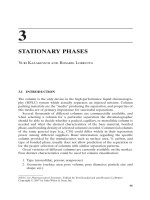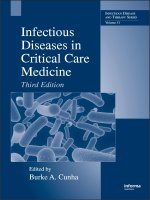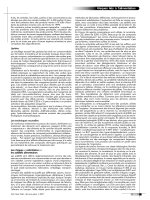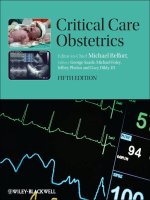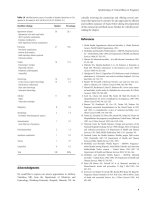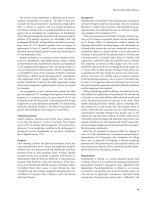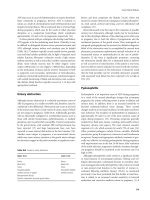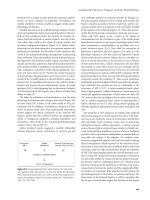Critical care medicine - part 3 docx
Bạn đang xem bản rút gọn của tài liệu. Xem và tải ngay bản đầy đủ của tài liệu tại đây (86.63 KB, 15 trang )
Heart Failure 33
A. Patients with a nondiagnostic ECG who have an indeterminate or a low
risk of MI should receive aspirin while undergoing serial cardiac enzyme
studies and repeat ECGs.
B. Treadmill stress testing should be considered for patients with a
suspicion of coronary ischemia.
Heart Failure
Congestive heart failure (CHF) is defined as the inability of the heart to meet the
metabolic and nutritional demands of the body. Approximately 75% of patients
with heart failure are older than 65-70 years of age. Approximately 8% of patients
between the ages of 75 and 86 have heart failure.
I. Etiology
A. The most common causes of CHF are coronary artery disease, hyperten-
sion, and alcoholic cardiomyopathy. Valvular diseases such as aortic
stenosis and mitral regurgitation, are also common.
B. Coronary artery disease is the etiology of heart failure in two-thirds of
patients with left ventricular dysfunction. Heart failure should be presumed
to be of ischemic origin until proven otherwise.
II. Clinical presentation
A. Left heart failure produces dyspnea and fatigue. Right heart failure leads
to lower extremity edema, ascites, congestive hepatomegaly, and jugular
venous distension. Symptoms of pulmonary congestion include dyspnea,
orthopnea, and paroxysmal nocturnal dyspnea. Clinical impairment is
caused by left ventricular systolic dysfunction (ejection fraction of less than
40%) in 80-90% of patients with CHF.
B. Patients should be evaluated for coronary artery disease, hypertension,
and valvular dysfunction. Use of alcohol, chemotherapeutic agents
(daunorubicin), negative inotropic agents, and symptoms of a recent viral
syndrome should be assessed.
C. CHF can present with shortness of breath, dyspnea on exertion, paroxys-
mal nocturnal dyspnea, orthopnea, nocturia, and cough. Exertional
dyspnea is extremely common in patients with heart failure.
Precipitants of Congestive Heart Failure
• Myocardial ischemia or infarc-
tion
• Atrial fibrillation
• Worsening valvular disease
• Pulmonary embolism
• Hypoxia
• Severe, uncontrolled hyperten-
sion
• Thyroid disease
• Pregnancy
• Anemia
• Infection
• Tachycardia or bradycardia
• Alcohol abuse
• Medication or dietary noncompli-
ance
D. Physical examination. Lid lag, goiter, medication use, murmurs, abnormal
heart rhythms may suggest a treatable underlying disease. Patients with
CHF may present with resting tachycardia, jugular venous distension, a
third heart sound, rales, lower extremity edema, or a laterally displaced
34 Heart Failure
apical impulse. Poor capillary refill, cool extremities, or an altered level of
consciousness may also be present.
New York Heart Association Criteria for Heart Failure
Class I Asymptomatic
Class II Symptoms with moderate activity
Class III Symptoms with minimal activity
Class IV Symptoms at rest
E. Laboratory assessment
1. Patients with symptoms suggestive of CHF should have a 12-lead
ECG.
2. Impedance cardiography (ICG) is a noninvasive, reliable method of
measuring cardiac index and stroke volume. It should be done on the
first day of hospitalization and repeated to assess response to drug
therapy.
3. A chest x-ray should be performed to identify pleural effusions,
pneumothorax, pulmonary edema, or infiltrates.
4. If cardiac ischemia or infarction is suspected, cardiac enzymes should
be drawn. A complete blood count, electrolytes, and digoxin level, if
applicable, also are mandatory. Patients with suspected hyper-
thyroidism should have thyroid function studies drawn.
F. Echocardiography is recommended to evaluate the presence of
pericardial effusion, tamponade, valvular regurgitation, wall motion
abnormalities, and ejection fraction.
Laboratory Workup for Suspected Heart Failure
Blood urea nitrogen
Cardiac enzymes (CK-MB,
troponin, or both)
Complete blood cell count
Creatinine
Electrolytes
Liver function tests
Magnesium
Thyroid-stimulating hormone
Urinalysis
Echocardiogram
Electrocardiography
Impedance cardiography
III. Management of chronic heart failure
A. Patients should also be placed on oxygen to maintain adequate oxygen
saturation. In patients with severe symptoms (ie, pulmonary edema),
continuous positive airway pressure (CPAP) or endotracheal intubation
(ETI) may be employed.
B. Angiotensin-converting enzyme inhibitors significantly reduce morbidity
and mortality in CHF. Side effects include cough, worsening renal function,
hyperkalemia, hypotension, and the risk of angioedema. ACEIs should be
started at a very low dose and titrated up gradually to relieve shortness of
breath. Renal function and electrolytes should be monitored.
Heart Failure 35
ACE Inhibitors Used for Heart Failure
Benazepril (Lotensin) – start 10 mg po bid, target 20-40 mg po bid
Captopril (Capoten) – start 6.25-12.5 mg po tid, target dose 50-100 mg tid
Enalapril (Vasotec) – start 2.5 mg po qd/bid, target 2.5-10 mg tid
Fosinopril (Monopril) – start 10 mg po qd, target 20-40 mg/d
Lisinopril (Prinivil, Zestril) – start 5 mg po qd, target 5-20 mg/d
Quinapril (Accupril) – start 5 mg po bid, target 20-40 mg/d
Ramipril (Altace) – start 2.5 mg po bid, target 10 mg/d
Trandolapril (Mavik) – start 1 mg po qd, target 2-4 mg qd
C. Angiotensin II receptor blockers (ARBs). In patients who cannot tolerate
or have contraindications to ACE inhibitors, ARBs should be considered.
ARBs are as effective as ACE inhibitors with a lower incidence of cough
and angioedema.
Angiotensin II Receptor Blockers for Heart Failure
Candesartan (Atacand)
– start 4-8 mg qd bid, target 8-16 mg qd bid
Irbesartan (Avapro)
– start 75-150 mg qd, target 150-300 mg qd
Losartan (Cozaar)
– start 25-50 mg qd, target 50 mg bid
Valsartan (Diovan)
– start 80 mg qd, target 160-320 mg qd
D. Hydralazine/Isordil combination may be used in patients who are
intolerant to ACE-inhibitors and ARBs; however, this combination is less
effective in reducing mortality. Hydralazine can cause reflex tachycardia
and increase ischemic pain. Reflex tachycardia due to hydralazine may be
beneficial in patients with bradycardia caused by beta-blockers. The
dosage of hydralazine is 10-50 mg qid, combined with isosorbide dinitrate
(Isordil) 10-40 mg qid, OR isordil mononitrate (Imdur) 30-60 mg qd.
E. Diuretics induce peripheral vasodilation, reduce cardiac filling pressures,
and prevent fluid retention. Loop diuretics are the most potent agents in
CHF. Diuretics should be prescribed for patients with heart failure who
have volume overload.
Diuretic Therapy in Congestive Heart Failure
Loop diuretics
• Furosemide (Lasix) – 20-200 mg IV/PO daily or bid, or 10-20 mg/hr IV
infusion
• Bumetanide (Bumex) – 0.5-4.0 mg IV/PO daily or bid
• Torsemide (Demadex) – 5-100 mg IV/PO daily
Long-acting thiazide diuretics
• Metolazone (Zaroxolyn) – 2.5-10.0 mg qd PO bid
• Hydrochlorothiazide – 25 PO mg qd
Aldosterone Antagonists
• Spironolactone (Aldactone) 12.5-25 mg PO qd
F. Beta-Blockers are beneficial in heart failure, improving contractility and
survival. Beta-blockers should be started at low doses and advanced
36 Heart Failure
slowly. Beta-blockers should not be used in acute pulmonary edema or
decompensated heart failure, and they should only be initiated in the
stable patient. Beta-blockers are an add-on therapy for patients being
treated with ACE inhibitors.
Carvedilol, Metoprolol, and Bisoprolol – Dosages and Side Effects
• Carvedilol (Coreg) – start at 1.625-3.125 mg bid; target dose 25-50 mg
bid
• Metoprolol (Lopressor) – start at 12.5 mg bid; target dose 100 mg bid
• Bisoprolol (Zebeta) – start at 1.25 mg qd; target dose 10 mg qd
Digoxin Dosing
• Start at 0.250 mg/d with near normal renal function; start at 0.125 mg/d
if renal function impaired.
• Maintain serum digoxin level of 0.8-1.2 ng/mL.
G. Digoxin does not improve survival in CHF (as do ACE-inhibitors and
beta-blockers). Digoxin maybe added to a regimen of ACE-inhibitors and
diuretics if symptoms of heart failure persist. Digoxin can increase
exercise tolerance, improve symptoms, and decrease the risk of
hospitalization.
H. Spironolactone improves mortality in severe CHF and should be used
in addition to an ACE-inhibitor or ARB. A dosage of 25 mg qd should be
considered in patients with severe CHF. It can cause hyperkalemia, rash,
and gynecomastia.
I. Nonpharmacologic treatments
1. Salt restriction (a diet with 2 g sodium or less), alcohol restriction,
water restriction for patients with severe renal impairment, and regular
aerobic exercise as tolerated.
2. Synchronized biventricular pacing in patients with an ejection fraction
of <40% and wide QRS duration of >150 msec may improve symp-
toms and the overall clinical course.
J. Inotropic support
1. Positive inotropic agents improve quality of life and reduce need for
hospitalization but increase mortality. Parenterally positive inotropic
therapy increases cardiac output and decreases symptoms of
congestion.
2. Parenteral inotropic agents can be administered continuously in
patients with exacerbations of heart failure. These agents may be
administered continuously or intermittently at home. Impedance
cardiography is used to assess clinical response before and during
treatment.
Atrial Fibrillation 37
Inotropic Agents for Cardiogenic Shock
• Milrinone (Primacor) – start at 0.375 mcg/kg/min and titrate to 0.75
mcg/kg/min
• Dobutamine (Dobutrex) – start at 2-3 mcg/kg/min and titrate 5
mcg/kg/min
• Dopamine (Intropin) – start at 2-5 mcg/kg/min and titrate to 10
mcg/kg/min
K. Natriuretic peptides
1. Atrial and brain natriuretic peptides regulate cardiovascular homeosta-
sis and fluid volume.
2. Nesiritide (Natrecor) is structurally similar to atrial natriuretic peptide.
It has natriuretic, diuretic, vasodilatory, smooth-muscle relaxant
properties, and inhibits the renin-angiotensin system. Nesiritide is
indicated for the treatment of moderate-to-severe heart failure.
3. The initial dose of nesiritide is 0.015 mcg/kg/min IV infusion slowly
titrated to max 0.03 mcg/kg/min. Hypotension occurs frequently with a
mild increase in heart rate.
Treatment of Acute Heart Failure/Pulmonary Edema
• Oxygen therapy, 2 L/min by nasal canula
• Furosemide (Lasix) 20-80 mg IV (patients already on outpatient dose
may require more)
• Nitroglycerine start at 10-20 mcg/min and titrate to BP (use with cau-
tion if inferior/right ventricular infarction suspected)
• Sublingual nitroglycerin 0.4 mg
• Morphine sulfate 2-4 mg IV. Avoid if inferior wall MI suspected or if
hypotensive or presence of tenuous airway
• Potassium supplementation prn
Atrial Fibrillation
Atrial fibrillation (AF) is the most common arrhythmia. The median age of onset
is 75, and the incidence and prevalence increase dramatically with age. For
patients older than 80 years, the incidence of AF is 9%. For patients aged 80-90,
nearly one-third of strokes that occur are related to AF.
I. Pathophysiology. The cardiac conditions most commonly associated with
AF are coronary artery disease, hypertension, rheumatic heart disease, mitral
valve disease, cardiomyopathies, and open-heart surgery. Hypertension and
coronary artery disease are the most frequent risk factors, accounting for 65%
of AF cases. The most common noncardiac causes are pulmonary diseases
(including COPD), hypoxia, and hyperthyroidism.
II. Clinical evaluation
Atrial Fibrillation 39
younger than 65 and without these risk factors (lone AF), aspirin
alone may be appropriate for stroke prevention.
4. Patients between the ages of 65 and 75 with none of these risk
factors could be treated with either warfarin or aspirin.
5. In patients older than 75 with AF, oral anticoagulation with warfarin is
recommended. In patients with major contraindications to warfarin
(intracranial hemorrhage, unstable gait, falls, syncope, or poor
compliance), a daily aspirin is a reasonable alternative.
6. If the duration of AF is unknown or more than 48 hours, then rate
control and anticoagulation therapy should be initiated first. The
patient should be evaluated for the presence of an intracardiac
thrombus with a transesophageal echocardiography (TEE). If the TEE
demonstrates a clot, the patient is anticoagulated for three weeks
before a scheduled cardioversion. If no left atrial thrombus is
identified by TEE, heparin is started and the patient is cardioverted.
Following successful cardioversion, the patient is placed on warfarin
for an additional four weeks.
C. Rate control
1. Patients with AF of greater than one year duration or a left atrial size
greater than 50 mm may have difficulty in converting to sinus rhythm.
In these patients, rate control, rather than conversion to sinus rhythm
may, be beneficial. A controlled ventricular rate in AF is less than 90
bpm at rest.
2. The pharmacological agents used for rate control are calcium channel
blockers (diltiazem, verapamil), beta-blockers (metoprolol, esmolol)
and digoxin. Calcium channel blockers should be used first because
of rapid onset of action compared to digoxin, which takes 4-6 hours
to show pharmacological effect. Digoxin is the first drug of choice in
significant left ventricular dysfunction.
3. Calcium channel blockers can slow AV node conduction and are
first-line agents for rate control therapy.
4. Beta-blockers slow AV nodal and sinoatrial nodal conduction. The
most commonly used beta-blockers are metoprolol and atenolol.
5. Digoxin has numerous drug interactions, an unpredictable dose
response curve, and a potentially lethal toxicity. Digoxin is is reserved
for patients with systolic dysfunction and heart failure.
Agents Used for Heart Rate Control in Atrial Fibrillation
Agent Loading
Dose
Onset of Ac-
tion
Maintenance
Dosage
Major Side
Effects
Diltiazem
(Cardizem)
0.25 mg per
kg IV over 2
minutes, may
repeat dose
with 0.35
mg/kg after 15
min x 1
2-7 minutes 5-15 mg per
hour IV or 120-
360 mg PO ev-
ery day in div-
ided doses
Hypotension,
heart block,
heart failure
Verapamil
(Calan,
Isoptin)
0.075-0.15 mg
per kg IV over
2 minutes
3-5 minutes 240-360 mg PO
every day in
divided doses
Hypotension,
heart block,
heart failure
40 Atrial Fibrillation
Agent Loading
Dose
Onset of Ac-
tion
Maintenance
Dosage
Major Side
Effects
Esmolol
(Brevibloc)
0.5 mg per kg
IV over one
minute
5 minutes 0.05-0.2
mg/kg/minute
IV
Hypotension,
heart block,
bradycardia,
asthma, heart
failure
Metoprolol
(Lopressor)
2.5-5 mg IV
bolus over 2
minutes, up to
3 doses
5 minutes 50-200 mg PO
every day in 2
daily doses
Hypotension,
heart block,
bradycardia,
asthma, heart
failure
Propranolol
(Inderal)
0.15 mg per
kg
5 minutes 40-320 mg PO
every day in
divided doses
Hypotension,
heart block,
bradycardia,
asthma, heart
failure
Digoxin
(Lanoxin)
0.25 mg IV or
PO every 4
hours, up to
1.0-1.5 mg
4-6 hours 0.125-0.25 mg
PO/IV qd
Digitalis toxic-
ity, heart
block, brady-
cardia, ven-
tricular fibrilla-
tion
Agents Used for Heart Rate Control in Atrial Fibrillation
Drug Mechanism
of Action
ECG
Changes
Dose Adverse Re-
action
Class la Agents
Quinidine Decrease Na
influx
Reduce
upstroke
velocity,
Prolong
repolariza-
tion
QRS wid-
ens, QT
lengthens
Sulfate 300-600
mg po q6-8hrs
Quinaglute 324-
628 mg po q8-
12 hrs
GI, cinchonism
VT/VF/
Torsade de
Pointes
Procain-
amide
QRS wid-
ens, QT
lengthens
Load: IV 13-17
mg/kg over 30-
60 min
Maintenance: IV
2-4 mg/min or
Procan SR 750-
1500 mg po
q6hr
SLE-like syn-
drome, confu-
sion
Atrial Fibrillation 41
Class Ic Agents
Flecainide Reduction in
upstroke
velocity
QRS wid-
ens, QT
lengthens
Start 50-100 mg
po q12hr; max.
200 bid
Dizziness,
headaches
Propa-
fenone
QRS wid-
ens, QT
lengthens
Start 150 mg po
q8hrs; max. 300
mg po q8hr
Dry mouth, GI,
dizziness
Class III Agents
Amio-
darone
Blocks K
efflux, pro-
longs
repolar-
ization
Dose-
depend-
ant QT
prolonga-
tion
Load 400 mg po
tid x 7-14 days,
then 400 mg po
qd x 1 month;
Maintenance:
100-400 mg/day
Ataxia, trem-
ors pulmonary
fibrosis, pneu-
mon-
itis/alveolitis,
skin discolor-
ation, thyroid
and LFT
abnormalities
Sotalol Potent beta-
blocking ac-
tivity
80 mg po bid;
max. 160 mg bid
Bradycardia,
Torsade de
Pointes.
Ibutilide Prolong ac-
tion potential
and refrac-
tory period
1 mg IV infusion
over 10 min,
may repeat once
after 10 min
Torsade in 3-
8%
Dofetilide 125-500 mcg
bid, depending
on renal function
0.5-10% tor-
sade
D. Antiarrhythmics. Restoration of sinus rhythm is the optimal goal, as it
may relieve symptoms and improve cardiac output.
1. Class Ia. These medications act by blocking the fast sodium
channel, reducing the impulse conduction through the myocardium.
a. Quinidine can be used for acute conversion as well as to
maintain of sinus rhythm.
b. Procainamide can also be used for both acute conversion and
maintenance. It is slightly less effective than quinidine.
c. Disopyramide has negative inotropic properties. Disopyramide
is infrequently used in the treatment of AF due to poor efficacy
and frequent side effects.
2. Class lc. This class of medications acts by prolonging
intraventricular conduction.
a. Flecainide can cause acute conversion to sinus rhythm in 50-
55%. Due to its negative inotropic action, flecainide should be
used cautiously in patients with AF and hypertrophic
cardiomyopathy. It should not be used in patients with structural
42 Hypertensive Emergency
heart disease. It is reserved for patients with normal LV function
and refractory AF.
b. Propafenone may have fewer side effects and is better tolerated
than the Ia agents. It is available only in an oral form and can also
be given as a single bolus dose for AF of less than 24 hours.
Proarrhythmia can occur but is reported less frequently than with
the other Ic medications. Propafenone is useful for patients who
are hypertensive and have a structurally normal heart with AF.
Propafenone should be avoided in patients with structural heart
disease.
3. Class III. The medications in this class act by blocking outward
potassium currents, resulting in increased myocardial refractoriness.
All class III agents cause a dose-dependent QTc prolongation,
resulting in Torsades de Pointes. These agents are contraindicated
if the QTc is >0.44 seconds.
a. Amiodarone (Cordarone) has sodium, calcium, and beta-
blocking effects. Amiodarone has a low proarrhythmia profile. It is
safe and efficacious in patients with CHF and AF. Side effects
include pulmonary fibrosis, pneumonitis, skin discoloration, thyroid
and liver abnormalities, ataxia, and tremors (33%).
b. Sotalol (Betapace) has a beta-blocking effect. It is less effective
than quinidine, with a conversion rate of 20%. It is most appropri-
ate for sinus maintenance in patients with AF and coronary artery
disease. Sotalol should be avoided in patients with severe LV
dysfunction and COPD.
c. Ibutilide (Corvert) is highly effective for the conversion of recent
onset AF (30%) and atrial flutter (70%). Polymorphic ventricular
tachycardia occurs in about 6%. Pretreatment with magnesium
may prevent polymorphic ventricular tachycardia.
d. Dofetilide (Tikosyn) is indicated for acute conversion and
maintenance of atrial fibrillation. The success rate in acute
conversion is 30%.
E. Nonpharmacologic strategies. Due to drug intolerance, possible
proarrhythmic effects, and disappointing long-term efficacy of the
antiarrhythmic agents, non-pharmacological therapies have an important
role in the management of AF.
1. Electrical cardioversion is rapid and highly effective, with success
rates greater than 80%.
2. Radiofrequency catheter ablation/atrial defibrillators. The
delivery of radiofrequency current through a catheter tip advanced to
the atrium is highly effective and safe.
Hypertensive Emergency
Hypertensive crises are severe elevations in blood pressure (BP) characterized
by a diastolic blood pressure (BP) higher than 120-130 mm Hg.
I. Clinical evaluation of hypertensive crises
A. Hypertensive emergency is defined by a diastolic blood pressure >120
mm Hg associated with ongoing vascular damage. Symptoms or signs of
Hypertensive Emergency 43
neurologic, cardiac, renal, or retinal dysfunction are present. Hypertensive
emergencies include severe hypertension in the following settings:
1. Aortic dissection
2. Acute left ventricular failure and pulmonary edema
3. Acute renal failure or worsening of chronic renal failure
4. Hypertensive encephalopathy
5. Focal neurologic damage indicating thrombotic or hemorrhagic stroke
6. Pheochromocytoma, cocaine overdose, or other hyperadrenergic
states
7. Unstable angina or myocardial infarction
8. Eclampsia
B. Hypertensive urgency is defined as diastolic blood pressure >120 mm
Hg without evidence of vascular damage; the disorder is asymptomatic
and no retinal lesions are present.
C. Causes of secondary hypertension include renovascular hypertension,
pheochromocytoma, cocaine use, withdrawal from alpha-2 stimulants,
clonidine, beta-blockers or alcohol, and noncompliance with
antihypertensive medications.
44 Hypertensive Emergency
II. Initial assessment of severe hypertension
A. When severe hypertension is noted, the measurement should be repeated
in both arms to detect any significant differences. Peripheral pulses should
be assessed for absence or delay, which suggests dissecting aortic
dissection. Evidence of pulmonary edema should be sought.
B. Target organ damage is suggested by chest pain, neurologic signs,
altered mental status, profound headache, dyspnea, abdominal pain,
hematuria, focal neurologic signs (paralysis or paresthesia), or hyperten-
sive retinopathy.
C. Prescription drug use should be assessed, including missed doses of
antihypertensives. History of recent cocaine or amphetamine use should
be sought.
D. If focal neurologic signs are present, a CT scan may be required to
differentiate hypertensive encephalopathy from a stroke syndrome.
III. Laboratory evaluation
A. Complete blood cell count, urinalysis for protein, glucose, and blood; urine
sediment examination; chemistry panel (SMA-18).
B. If chest pain is present, cardiac enzymes are obtained.
C. If the history suggests a hyperadrenergic state, the possibility of a
pheochromocytoma should be excluded with a 24-hour urine for catechol-
amines. A urine drug screen may be necessary to exclude illicit drug use.
D. Electrocardiogram should be completed.
E. Suspected primary aldosteronism can be excluded with a 24-hour urine
potassium and an assessment of plasma renin activity. Renal artery
stenosis can be excluded with captopril renography and intravenous
pyelography.
Screening Tests for Secondary Hypertension
Renovascular Hyper-
tension
Captopril renography: Renal scan before and after 25 mg
PO
Intravenous pyelography
MRI angiography
Hyperaldosteronism
Serum potassium
24-hr urine potassium
Plasma renin activity
CT scan of adrenals
Pheochromocytoma
24-hr urine catecholamines
CT scan
Nuclear MIBG scan
Cushing's Syndrome
Plasma ACTH
Dexamethasone suppression test
Hyperparathyroidism
Serum calcium
Serum parathyroid hormone
IV. Management of hypertensive emergencies
A. The patient should be hospitalized for intravenous access, continuous
intra-arterial blood pressure monitoring, and electrocardiographic
monitoring. Volume status and urinary output should be monitored.
Hypertensive Emergency 45
Rapid, uncontrolled reductions in blood pressure should be avoided
because coma, stroke, myocardial infarction, acute renal failure, or death
may result.
B. The goal of initial therapy is to terminate ongoing target organ damage.
The mean arterial pressure should be lowered not more than 20-25%, or
to a diastolic blood pressure of 100 mm Hg over 15 to 30 minutes.
V. Parenteral antihypertensive agents
A. Nitroprusside (Nipride)
1. Nitroprusside is the drug of choice in almost all hypertensive emergen-
cies (except myocardial ischemia or renal impairment). It dilates both
arteries and veins, and it reduces afterload and preload. Onset of
action is nearly instantaneous, and the effects disappear 1-2 minutes
after discontinuation.
2. The starting dosage is 0.25-0.5 mcg/kg/min by continuous infusion
with a range of 0.25-8.0 mcg/kg/min. Titrate dose to gradually reduce
blood pressure over minutes to hours.
3. When treatment is prolonged or when renal insufficiency is present,
the risk of cyanide and thiocyanate toxicity is increased. Signs of
thiocyanate toxicity include anorexia, disorientation, fatigue, hallucina-
tions, nausea, toxic psychosis, and seizures.
B. Nitroglycerin
1. Nitroglycerin is the drug of choice for hypertensive emergencies with
coronary ischemia. It should not be used with hypertensive
encephalopathy because it increases intracranial pressure.
2. Nitroglycerin increases venous capacitance, decreases venous return
and left ventricular filling pressure. It has a rapid onset of action of 2-5
minutes. Tolerance may occur within 24-48 hours.
3. The starting dose is 15 mcg IV bolus, then 5-10 mcg/min (50 mg in
250 mL D5W). Titrate by increasing the dose at 3- to 5-minute inter-
vals up to max 1.0 mcg/kg/min.
C. Labetalol IV (Normodyne)
1. Labetalol is a good choice if BP elevation is associated with
hyperadrenergic activity, aortic dissection, an aneurysm, or post-
operative hypertension.
2. Labetalol is administered as 20 mg slow IV over 2 min. Additional
doses of 20-80 mg may be administered q5-10min, then q3-4h prn or
0.5-2.0 mg/min IV infusion. Labetalol is contraindicated in obstructive
pulmonary disease, CHF, or heart block greater than first degree.
D. Enalaprilat IV (Vasotec)
1. Enalaprilat is an ACE-inhibitor with a rapid onset of action (15 min) and
long duration of action (11 hours). It is ideal for patients with heart
failure or accelerated-malignant hypertension.
2. Initial dose, 1.25 mg IVP (over 2-5 min) q6h, then increase up to 5 mg
q6h. Reduce dose in azotemic patients. Contraindicated in bilateral
renal artery stenosis.
E. Esmolol (Brevibloc) is a non-selective beta-blocker with a 1-2 min onset
of action and short duration of 10 min. The dose is 500 mcg/kg/min x 1
min, then 50 mcg/kg/min; max 300 mcg/kg/min IV infusion.
F. Hydralazine is a preload and afterload reducing agent. It is ideal in
hypertension due to eclampsia. Reflex tachycardia is common. The dose
is 20 mg IV/IM q4-6h.
46 Ventricular Arrhythmias
G. Nicardipine (Cardene IV) is a calcium channel blocker. It is contrain-
dicated in presence of CHF. Tachycardia and headache are common.
The onset of action is 10 min, and the duration is 2-4 hours. The dose
is 5 mg/hr continuous infusion, up to 15 mg/hr.
H. Fenoldopam (Corlopam) is a vasodilator. It may cause reflex tachycar-
dia and headaches. The onset of action is 2-3 min, and the duration is 30
min. The dose is 0.01 mcg/kg/min IV infustion titrated, up to 0.3
mcg/kg/min.
I. Phentolamine (Regitine) is an intravenous alpha-adrenergic antagonist
used in excess catecholamine states, such as pheochromocytomas,
rebound hypertension due to withdrawal of clonidine, and drug ingestions.
The dose is 2-5 mg IV every 5 to 10 minutes.
J. Trimethaphan (Arfonad) is a ganglionic-blocking agent. It is useful in
dissecting aortic aneurysm when beta-blockers are contraindicated;
however, it is rarely used because most physicians are more familiar with
nitroprusside. The dosage of trimethoprim is 0.3-3 mg/min IV infusion.
Ventricular Arrhythmias
I. Ventricular fibrillation and tachycardia
-If unstable (see ACLS protocol page 5), defibrillate with unsynchronized
200 J, 300 J, then 360 J.
-Oxygen 100% by mask.
-Procainamide loading dose 10-15 mg/kg at 20 mg/min IV or 100 mg IV
q10min, then 2-4 mg/min IV maintenance OR
-Also see “other antiarrhythmics” below.
II. Torsades de Pointes
-Correct underlying cause and consider discontinuing drugs that cause
Torsades de Pointes (dofetilide, ibutilide, sotalol, amiodarone, quinidine,
procainamide, disopyramide, moricizine, bepridil, phenothiazines, tricyclic
and tetracyclic antidepressants, vasopressin, imidazoles, pentamidine);
correct hypokalemia and hypomagnesemia.
-Defibrillate with 360 J.
-Magnesium sulfate (drug of choice), 2 gm IV push.
-Isoproterenol (Isuprel) 2-20
:g/min (2 mg in 500 mL D5W, 4 :g/mL) OR
-Phenytoin (Dilantin) 100-300 mg IV given in 50 mg increments q5min.
III. Other antiarrhythmics
Class Ib
-Lidocaine 50-100 mg (1 mg/kg) IV, then 2-4 mg/min IV.
-Mexiletine (Mexitil) 100-200 mg PO q8h, max 1200 mg/d.
-Tocainide (Tonocard) loading 400-600 mg PO, then 400-600 mg PO q8-12h;
max 1800 mg/d.
-Phenytoin (Dilantin), loading dose 15 mg/kg at 50 mg/min, then 100 IV q8h.
Class Ic
-Flecainide (Tambocor) 50-100 mg PO q12h, max 400 mg/d.
-Propafenone (Rythmol) 150-300 mg PO q8h, max 1200 mg/d.
Class III
-Amiodarone (Cordarone) PO loading 400-1200 mg/d in divided doses x 5-14
days, then 200-400 mg PO qd OR 150 mg slow IV over 10 min, then 1
mg/min IV infusion x 6 hours then 0.5 mg/min IV infusion thereafter.
-Sotalol (Betapace) 40-80 mg PO bid, max160 mg bid.
Labs: SMA 12, Mg, calcium, CBC, cardiac enzymes, LFTs, ABG, drug
levels, thyroid function test. ECG, electrophysiologic study.
Acute Pericarditis
Pericarditis is the most common disease of the pericardium. The most common
cause of pericarditis is viral infection. This disorder is characterized by chest
pain, a pericardial friction rub, electrocardiographic changes, and pericardial
effusion.
I. Clinical features
A. Chest pain of acute infectious (viral) pericarditis typically develops in
younger adults 1 to 2 weeks after a “viral illness.” The chest pain is of
sudden and severe onset, with retrosternal and/or left precordial pain and
referral to the back and trapezius ridge. Pain may be preceded by low-
grade fever. Radiation to the arms may also occur. The pain is often
pleuritic (eg, accentuated by inspiration or coughing) and may also be
relieved by changes in posture (upright posture).
B. A pericardial friction rub is the most important physical sign. It is often
described as triphasic, with systolic and both early (passive ventricular
filling) and late (atrial systole) diastolic components, or more commonly
a biphasic (systole and diastole).
C. Resting tachycardia (rarely atrial fibrillation) and a low-grade fever may be
present.
Causes of Pericarditis
Idiopathic
Infectious: Viral, bacterial, tubercu-
lous, parasitic, fungal
Connective tissue diseases Meta-
bolic: uremia, hypothyroidism Neo-
plasm, radiation
Hypersensitivity: drug
Postmyocardial injury syndrome
Trauma
Dissecting aneurysm
Chylopericardium
II. Diagnostic testing
A. ECG changes. During the initial few days, diffuse (limb leads and
precordial leads) ST segment elevations are common in the absence of
reciprocal ST segment depression. PR segment depression is also
common and reflects atrial involvement.
B. The chest radiograph is often unrevealing, although a small left pleural
effusion may be seen. An elevated erythrocyte sedimentation rate and
C-reactive protein (CRP) and mild elevations of the white blood cell
count are also common.
C. Labs: CBC, SMA 12, albumin, viral serologies: Coxsackie A & B,
measles, mumps, influenza, ASO titer, hepatitis surface antigen, ANA,
rheumatoid factor, anti-myocardial antibody, PPD with candida, mumps.
Cardiac enzymes q8h x 4, ESR, blood C&S X 2.
D. Pericardiocentesis: Gram stain, C&S, cell count & differential,
cytology, glucose, protein, LDH, amylase, triglyceride, AFB, specific
gravity, pH.
